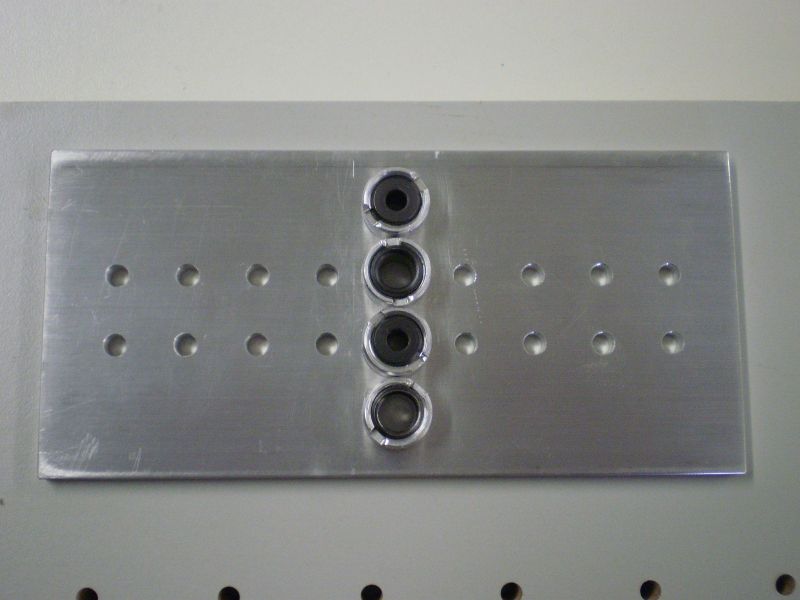Question
I'm new to the 32mm system and I'd really like to use it in some projects I've got coming up. My understanding is this system more or less allows for a common end panel and the doors and drawers are sized and located in increments of 32mm to allow the hinges and slides to land on common system holes - the shelf pin holes. Construction holes such as dowel holes and confirmat holes, once determined, can remain common from panel to panel as well.
My question comes with the horizontal spreaders that make a border between drawers over drawers or drawers over doors and how to fit them into the system. I can easily throw some construction holes in the end panels for dowels, confirmats, Rafix connectors, or whatever, but this leaves unique milling details in a 3 drawer vs. a 4 drawer vs. door/drawer end panel. Is there some hardware out there that I'm missing that allows these spreaders to attach using the system holes? What's the point of this whole 32mm system if in the end I still need a unique end panel for every configuration?
Forum Responses
(Cabinetmaking Forum)
From contributor A:
While we don't use dowels (we staple and screw cases together), we only have a middle stringer when there is a pair of doors under a drawer. This gives the top of the doors something to bump into.
On any single door cabinet with or without a drawer or drawer base, we use a stringer at the top of the case only, no intermediates.
This would cut down on the boring for most of your cases, then depending on how you are cutting, CNC or not, this could be tied into your program to only bore construction holes for a stringer if a cabinet is over a certain width.
One answer to your question is that drawers and doors are not necessarily sized to 32mm increments, but the reveals do fall on 32mm increments. If the reveals fall on the 32 increments then it becomes easier to locate items like stretchers and fixed shelves.
I have tried to use hardware pattern to locate the stretchers by dropping an 8mm bit in the head at the right place (we do not drill all the holes of the line bore, only the needed ones). It turned out to not be worth the trouble. It required that I use a 37mm setback for the first dowel hole in all my dowel patterns, and that caused problems with fixed shelves that have setbacks from the front of the case (also 32mm increments). Plus I still needed to drill a second hole (need at least two dowels for the stretcher). I would make the stretcher deep enough to reach the second line bore pattern, but that was ridiculous. In the end it is easier to bore the stretchers or fixed shelves separate from the line boring pattern.
We use our boring machines to drill the length or the width depending on the situation. Some hardware patterns are simpler to execute across the width of the board (in a base cabinet with 3 drawers for example). Sometimes it is easier to bore the length of "Y" axis of the panel (upper cabinets with adjustable shelves).
Your final question shows one of the big misconceptions of the 32mm system. All panels are not the same. This is true for 32mm cabs, dadoed cases, or any cabinets. Not even the low end generic closet companies have a "one pattern fits all" approach. The beauty of the 32mm system (or any logically devised set of production standards) is that everything is predictable. I do not need to know the measurement of the location of the drawer stretcher, only the drawer height. When setting up the machines in my shop we all know that everything falls on a 32mm number. The machines all have marks denoting the 32mm increments on the fences. It is predictable, therefore the setup is faster and less prone to mistake. I can take a guy off the street and have him running the boring machine in just 1 or 2 days.
The boring patterns are not the same, but the engineering behind them is consistent. This can work for any system. The only reason we use 32mm is that is the standard spacing on boring machines and CNC machines. People often do not realize how much faster their CNC can run if the boring patterns are on 32 increments.
Blums_Process_32_Manual_PDF.html">Blum's Process 32 Manual
I don't follow. For the face reveals to fall on 32mm increments the faces have to be sized in some increment of 32mm (32 x n - reveal). This is a primary element of the 32mm system.
For overlay faces I use 74mm deep stretchers with 2 holes 21/32/21. Depending on the layout, the mounting holes either straddle a system hole or the midpoint between two system holes. I use a drill bushing jig registered to system holes to drill the panel holes (the stretchers are bored on a flip-flop).

My point is that instead of focusing in the drawer and door height, it is sometimes helpful to focus on the boring pattern first because that is what is driving everything else. Door sizes are 32mm increments because the reveals are snapped to the 32mm pattern, therefore it is the pattern that I focus on. I like your jig. Good thinking.
We drill only where the hardware goes and when we operated without a CNC we did that with custom made jigs. Rockler has a system that would save you loads of time.
We bore on ptp and lay holes only where we need and the majority of construction holes are the same. As the above posters have mentioned, 32mm system lends itself to great predictability. Develop a system that works for you with your budget.